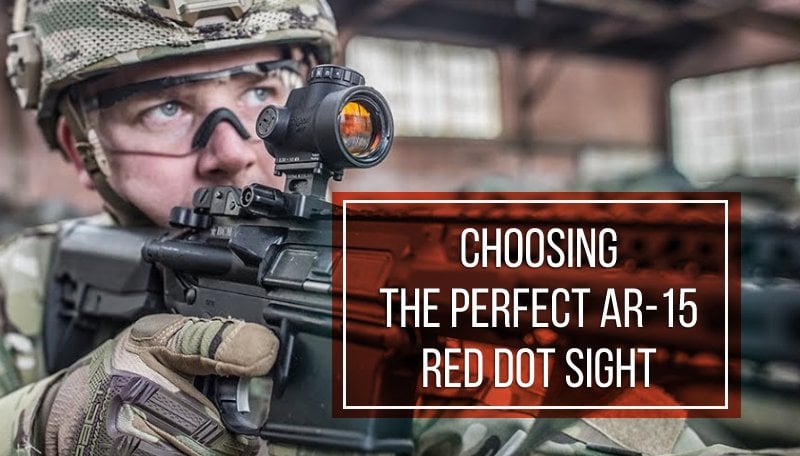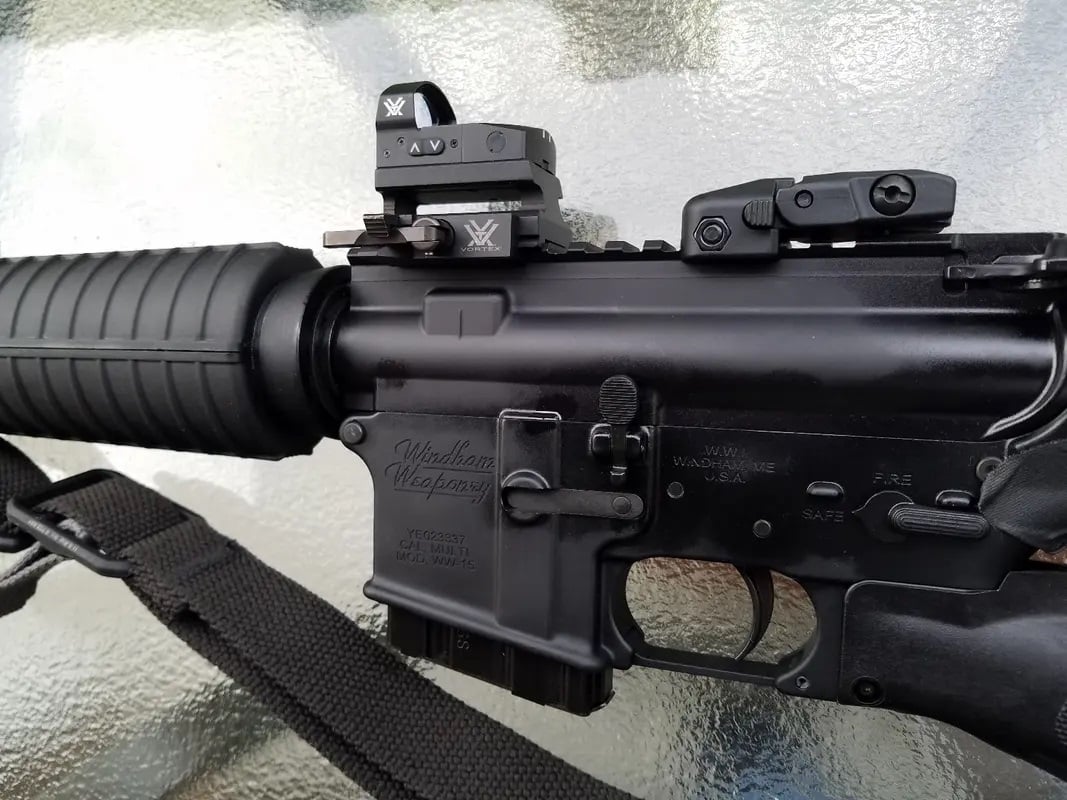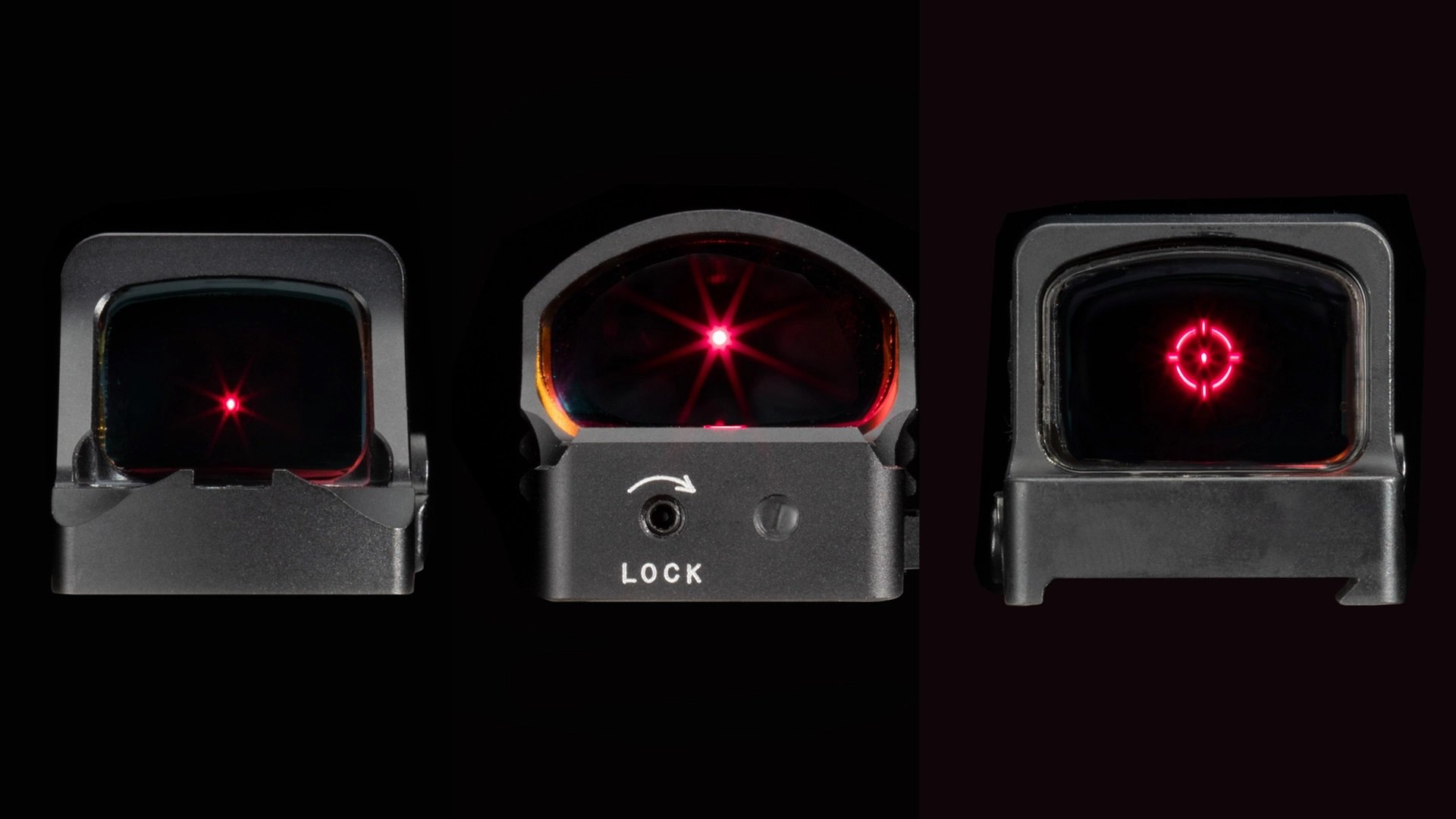
This post will guide you through some crucial things to consider when picking the perfect red dot sight for your AR-15 rifle. We’ll discuss how exactly red dots are different from other optics, what types of AR-15 red dot sights are there, and what pros and cons each offers. In the end, we will even provide the best red dot options. So whether you’re a hunter, range shooter, or competitor, read on to learn everything about choosing the perfect AR optics. If you are only after the best AR sights, jump here.
Table of Contents
What Exactly is a Red Dot Sight? Red Dot vs. Reflex
Unlike traditional iron sights, which require the shooter to align the front and rear sights with the target, a red dot sight uses an illuminated red dot or reticle to indicate where the shot will land. However, can any optic with a glowing aiming point be called a red dot sight? The answer is no.
The fundamental difference is in technology. Red dot sights use a LED to project an illuminated red dot onto a lens. The shooter looks through the lens and superimposes the red dot onto the target. On the other hand, holographic sights use a laser to create a reticle that is projected onto a holographic film. It creates a three-dimensional image that appears to be floating in front of the shooter’s eyes. Prism sights use an etched reticle that can be seen even when the sight isn’t powered.
You should also know that technically speaking, both “red dot sight” and “reflex sight” can be used interchangeably to describe any non-magnifying optic that uses a projected reticle for aiming. However, on the internet, “reflex sights” are often used to refer specifically to open-style sights with exposed lenses, while “red dot sights” are more commonly associated with tube-style sights with enclosed lenses.
It’s worth noting that there’s no such thing as a “red dot scope,” which would be a magnified red dot sight. However, there is a device called a sight magnifier. A sight magnifier attaches directly behind your red dot optic and provides additional magnification (usually 2x or 3x) without interfering with the function of the red dot itself. It allows you to switch between close-range shooting with just your red dot and mid-range shooting with added magnification without having to swap out optics entirely.
Summing up:
- Reflex Sights are the same as Red Dot Sights because both use the same technology.
- Reflex Sights often refer to Open-Style Sights, while Red Dot Sights refer to Tube-Style Sights.
- Red Dot Sights are non-magnified optic, but you can add a Sight Magnifier for longer-range shooting.
Now that you know what a reflex red dot sight is and what types are there, we’ll guide you through several important considerations.
Considerations When Choosing an AR-15 Red Dot Sight
Tube Sights vs. Open Sights (Red Dot Sights vs. Reflex Sights)

When choosing between open sights and tube sights for your AR-15 rifle, there are a few key differences to consider. One of the main differences is in the design of the housing.
Tube-style red dot sights have an enclosed housing that protects the optic from dust, dirt, moisture, and other elements. It also shields the lens from impacts, which can be important for shooters who use their firearms in rugged environments. So, generally, tubes may offer slightly better durability than open-style sights.
Open-style red dot sights, on the other hand, have less housing material blocking the view. It can make them faster to acquire targets and easier to see through in low-light conditions. However, because they lack enclosed housing, they may be more susceptible to damage from elements or impacts.
It’s worth noting that both open and tube-style red dot sights have an unlimited field of view (FOV) because they are non-magnifying optics designed to shoot with both eyes open. It means that you can maintain situational awareness while aiming your firearm.
In summary, consider factors like ease of target acquisition in different lighting conditions and susceptibility to environmental damage or impact damage. Ultimately, the choice will depend on your personal preferences and shooting needs.
Purpose & Magnification
The AR-15 rifle is one of the most versatile firearms on the market today. It can be used for various purposes, from long-range shooting competitions to hunting and home defense.
So, for those looking to use their AR15-style MSRs for long-range bench shooting competitions, 500 yards and farther, a red dot sight isn’t a viable option. Actually, you’d be better off with a riflescope with high magnification power and adjustment turrets (windage, elevation, and parallax).
However, if you plan to stay within 500 yards, that’s where the real discussion begins.
For home defense or other CQB engagements, an M4 rifle with a reflex sight is a winning combo. Open-style devices will allow for the quickest target acquisition thanks to the unlimited FOV and minimal housing. Besides, an open-lens reflex sight is the lightest option that doesn’t add bulk.
A tube sight will be a better option for those who want to use their AR-15s to shoot within 100 yards and in more rugged environments, such as hunting, 3-gun shooting, tactical games, and outdoor range plinking.
If you want to extend your range up to 300 yards, you can go with a combo of a red dot sight and a 3x sight magnifier. It will allow for almost a seamless switch between non-magnified and magnified views to reach farther. If you don’t need the range versatility this combo provides, opt for a low-powered variable optic (LPVO).
Reticle Size & Style

The reticle is the aiming point that you see when looking through the optic. It’s another crucial consideration when choosing between red dot sights for the AR-15.
Reticle size refers to the diameter of the aiming point. The size of a red dot is measured in minutes of angle (MOA). One MOA is equal to around 1 inch at 100 yards. It means that a 2 MOA red dot will appear approximately 2 inches in diameter at 100 yards, and a 4 MOA red dot will appear about 4 inches in diameter at the same distance. So, a larger reticle can be easier to see and faster to acquire, making it ideal for close-quarters shooting or fast-moving targets. However, a larger reticle may obscure smaller targets at longer distances, making precise shots more difficult.
Reticle style refers to the shape of the aiming point. There are several popular styles, including dot, crosshair, and chevron. Dot reticles are simple and easy to use. They offer quick target acquisition and allow for fast follow-up shots. However, they may be harder to see in low-light conditions or against busy backgrounds. Crosshair reticles provide greater precision than dot reticles, allowing for more accurate shots at longer ranges. However, they can be slower to acquire targets than dot reticles. Chevron reticles combine elements of both dot and crosshair styles. They offer quick target acquisition like a dot reticle but also provide greater precision like a crosshair reticle.
Battery Life
It’s one more factor to consider. After all, you don’t want your optic to die in the middle of a shoot or hunt.
First, consider the type of battery. Some sights use common batteries like CR2032, while others may use batteries that can be harder to find and replace. Next, look at the estimated battery life provided by the manufacturer. It can vary widely depending on factors like brightness settings. It’s also worth noting that some sights may have an automatic shut-off feature that helps conserve battery life when not in use. Finally, consider how easy it is to change the battery or adjust settings while in the field. Look for sights with easily accessible batteries.
Some of The Best AR-15 Sights: Reflex & Red Dot
Sig Sauer Romeo-MSR and Juliet 3 Micro Magnifier Combo
The Romeo sight offers fast target acquisition with its 2 MOA red dot reticle, and the Juliet 3 micro magnifier provides clear distortion-free images. This affordable combo can be used for close-range or long-range shooting.
Holosun HS510C
Provides a clear sight picture with its open frame design, solar power technology for extended battery life, shake awake feature for instant activation, and multiple reticle options.
Bushnell TRS-26
Offers a bright and clear sight picture with its 3 MOA red dot reticle. Features multi-coated lens for optimal light transmission, shockproof construction, and waterproof design. This Bushnell is one of the most affordable options that doesn’t sacrifice quality optics or durability.
Burris Fastfire 3
Perfect for CQB, it provides quick target acquisition with its 8 MOA red dot reticle. Also, it features automatic brightness adjustment based on ambient lighting conditions and lightweight, waterproof construction.
Leupold 119688 DeltaPoint Pro
It offers a crystal-clear sight picture with its DiamondCoat lens coating and saves battery due to its motion sensor technology. The sight features a 2.5 MOA red dot reticle and 1 MOA windage and elevation adjustments. Its durable aluminum construction can withstand heavy recoil from high-caliber AR-15 rifles.
Trijicon MRO
If you’re looking for exceptional performance, this sight features adjustable brightness settings, ½ MOA adjustments, weather-proof aluminum housing, and a distortion-free multi-coated lens. The red dot reticle size is 2 MOA.
Vortex Venom
Its multi-coated lens delivers bright sight pictures even during low-light conditions, and ArmorTek coating protects it from scratches, oil, and dirt. The battery tray is located at the top of the optic making it easier to change batteries. The model has an adjustable LED illumination system with auto-shutdown and an aluminum housing suitable for heavy-duty use.
FAQ
What is a red dot sight?
A red dot sight (or reflex sight) is a non-magnified optic that uses a LED reticle projected on the lens. It’s popular among shooters because it allows for quick and accurate target acquisition.
Why do I need a red dot sight for my AR-15 rifle?
A red dot sight can help you acquire targets quickly and accurately, making it an essential accessory for any shooter looking to improve their accuracy and speed.
What factors should I consider when choosing a red dot sight for my AR-15 rifle?
Factors to consider include sight style (open vs. tube), reticle size, reticle type, battery life, durability, and features (auto shutdown, multi-coated lens, fog-proofing, etc.)
Can I mount any red dot sight on my AR-15 rifle?
No. You need to ensure that the red dot sight you select is compatible with your AR-15’s rail system.
How do I know which size of the reticle is right for me?
The size of the reticle depends on your shooting needs. If you’re shooting at longer distances, consider a smaller reticle size that won’t obscure the view.




Leave a Reply